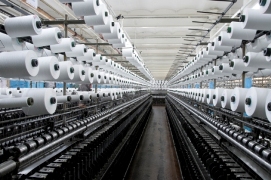According to the International Textile Machinery Federation (ITMF), shipments in most of the textile machinery segments experienced declines in 2014.

Deliveries of new short-staple spindles in 2014 fell by 15 per cent as against 2014, while long-staple spindles and open-end rotors increased by 70 per cent and 2.6 per cent, respectively.
The number of draw-texturing spindles grew by close to 12 per cent year on year in 2014 and shipments of shuttle-less looms dropped by 14 per cent over 2013.
Shipments of large circular knitting machines in 2014 also declined 22 per cent over its previous year. In contrast, shipments of flat-knitting machines surged by 31 per cent.
Shipments of new short-staple spindles fell by 15 per cent year-on-year in 2014 and more than reversed the increase of 10 per cent in 2013.
The shipments of short staple spindles declined to 9.8 million spindles, the lowest level since 2009 and also lower than the ten-year-average of 10.9 million.
Most of the new short staple spindles or 91 per cent were shipped to Asia, where shipments fell by nearly 17 per cent over 2013. Four of the five largest investors for short-staple spindles are from Asia.
The world’s largest investor of short-staple spindles, China, experienced a decline of nearly 29 per cent, but shipments to Turkey, the fourth largest investor, increased by 5 per cent in 2014.
Global shipments of long-staple spindles for wool soared by 70 per cent from 80,800 in 2013 to 137,650 in 2014, the strongest increase since 2012.
The majority of long-staple spindles or 69 per cent were shipped to Europe, of which shipments to Turkey rose to 67,000, which is equivalent to a share of 49 per cent of global shipments.
Within Europe, Belarus and Italy came second and third with shipments numbering 21,216 and 10,584 spindles.
In 2014, shipments to Asia increased marginally by 0.2 per cent to 29,000 spindles. While North and South America did not receive any shipments of long-staple spindles, shipments to Africa reached 432.
Shipments of open-end rotors improved moderately in 2014 by 2.6 per cent after they declined in the previous two years to reach 454,720, the highest level since 2011 and above long-term average of 402,669.
“Nearly 67 per cent of worldwide shipments of open-end rotors were destined for Asia though the pace is declining,” ITMF noted.
Shipments to Asia fell by 13 per cent after declines of 13.9 per cent and 11.9 per cent in 2013 and 2012, respectively.
Shipments to South America also declined 9.3 per cent. In contrast, shipments to Europe and, especially, North America saw strong increases of nearly 27 per cent and 402 per cent, respectively.
Global shipments of single heater draw-texturing spindles which are mainly used for polyamide filaments surged 76 per cent from 2,600 in 2013 to 4,576 in 2014.
Asia accounted for 57 per cent, where most of the single heater draw-texturing spindles were shipped to, followed by Western Europe with 20 per cent and South America with close to 15 per cent.
In the segment of double heater draw-texturing spindles which are mainly used for polyester filaments, the downward trend continued and global shipments fell by 12 per cent on an annual basis to 443,352.
However, the pace of decline moderated somewhat in 2014 compared to 2013 when shipments fell by nearly 30 per cent, with Asia’s share of worldwide shipments amounting to close to 88 per cent.
In 2014, worldwide shipments of shuttle-less looms fell by 14 per cent to 71,667 units, the third continuous year of decline in a row.
Shipments of water-jet shuttle-less looms dropped by 30 per cent to 24,220, the third fall since 2012 and shipments of air-jet looms also declined though this was the first fall after four years of increases.
The number of shipped air jet looms contracted by 19 per cent year on year to 20,176 in 2014. However deliveries of rapier and projectile looms shipments rose by 14 per cent over 2013 to 27,271 in 2014.
As in previous years the main destination of shuttle-less looms was Asia amounting to a share of 97 per cent of worldwide deliveries.
Water-jet looms accounted for 36 per cent of shipments to Asia, rapier and projectile looms made up for 35 per cent with air-jet looms making up the rest with 29 per cent.
In Europe and North America, 73 per cent and 54 per cent of shipments are for rapier and projectile looms, while the share of water-jet looms is only 7 per cent and 11 per cent, respectively.
Global shipments of large circular knitting machines fell by 22 per cent from 36,575 in 2013 to 28,502 in 2014, the lowest level since 2009.
Nearly 88 per cent of all circular knitting machines were shipped to Asia and with a share of 60 per cent or 17,000 shipments of worldwide deliveries, China is the single largest investor.
India and Turkey rank second and third with 2,464 units or 8.6 per cent share and 1,325 units or 4.6 per cent, respectively.
According to ITMF, 2014 was a good year for the segment of electronic flat knitting machines as global shipments grew by 31 per cent to 46,100 machines and the first increase since 2011.
Over 85 per cent of all deliveries went to Asia with China being the largest investor with a share of 42 per cent equivalent to over 19,000 units.
China was followed by Bangladesh with 11,312 units, Vietnam 1,956 units, Turkey with 1,879 machines and finally India ranked fifth with 1,840 units.





